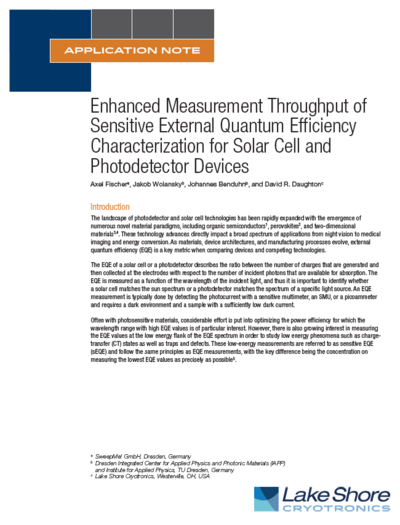Sensitive EQE Characterization with the M81-SSM: Unlocking New Insights in Photonic Materials
In the fast-paced evolution of solar cell and photodetector technologies — from organic semiconductors to perovskites and 2D materials — External Quantum Efficiency (EQE) characterization remains a vital tool for understanding and benchmarking device performance.
However, when it comes to probing low-energy phenomena such as charge-transfer (CT) states, defect levels, or sub-bandgap absorption, conventional EQE systems fall short. That’s where Sensitive EQE (sEQE) measurements come into play — enabling researchers to explore extremely weak signals with high precision.
What is sEQE and why does it matter?
EQE quantifies the ratio of charge carriers collected at the electrodes versus incident photons. But in the sub-bandgap region (typically below 1.5 eV), the photocurrent is often orders of magnitude weaker, requiring ultra-sensitive instrumentation.
Sensitive EQE allows scientists to:
- Resolve charge-transfer states at donor–acceptor interfaces
- Identify trap states and non-radiative recombination pathways
- Quantify internal voltage losses that limit power conversion efficiency
The challenge: High sensitivity with wide dynamic range
Traditional sEQE setups involve:
- Lock-in amplifiers for modulated AC signal detection
- Ultra-low-noise transimpedance amplifiers
- External software to coordinate light source, monochromator, and filters
- Rewiring between AC (lock-in) and DC (I-V) measurements
This makes the process time-consuming and error-prone, particularly for low-yield or complex material systems.
The solution: M81-SSM platform with CM-10 modules
In a collaborative application study with SweepMe! and TU Dresden, the M81 Synchronous Source Measure system replaced a traditional sEQE setup and demonstrated outstanding performance and workflow simplification:
1. Seamless switching between AC and DC modes
The same CM-10 modules can perform:
- DC I–V sweeps for device verification
- Lock-in mode sEQE without rewiring
"Configuration switching is handled via software, eliminating manual reconnections."
2. Intelligent autoranging for high dynamic range
The system adapts gain settings in real time across photocurrents that vary by over six orders of magnitude — without compromising accuracy.
"The OSC device tested showed photocurrent shifts over 7 decades. The full forward/reverse scan, including filter changes, was completed in just 231 seconds."
3. Synchronous reference detection
The calibrated photodiode signal is demodulated in sync with the DUT signal, enabling accurate EQE normalization at every wavelength.
"Internal ADCs allow simultaneous acquisition of magnitude and phase for both channels in real time."
Case study: ZnPc:C60 organic solar cell
An OSC based on a ZnPc:C60 donor-acceptor system was measured using the M81-SSM. The results included:
- A full sEQE spectrum from 0.5 to 3.5 eV
- Clear CT absorption feature between 1.0 and 1.5 eV
- Uniform performance over six orders of signal magnitude
"The sEQE spectrum revealed the excitonic peaks of ZnPc and C60, along with a distinct low-energy CT state response."
Operational benefits for your lab
- Rapid full-spectrum scan — < 4 minutes including filters
- No hardware switching — AC and DC in the same setup
- Ultra-low noise — < 1 nA current resolution
- Scalable and flexible — Ideal for perovskites, IR detectors, quantum materials
Ready to try it in your lab?
Contact Quantum Design Italy to schedule a personalized demo or discuss your specific measurement needs. We're here to support advanced characterization in materials science and photonics.
Read the full Application Note
| +39 06 5004204 | |
| +39 06 5010389 | |
| dubaldoqd-europe.com |



